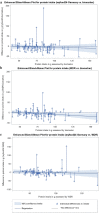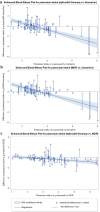Validation of the web-based self-administered 24-h dietary recall myfood24-Germany: comparison with a weighed dietary record and biomarkers
- PMID: 33974128
- PMCID: PMC8437850
- DOI: 10.1007/s00394-021-02547-7
Validation of the web-based self-administered 24-h dietary recall myfood24-Germany: comparison with a weighed dietary record and biomarkers
Abstract
Purpose: We aimed to validate myfood24-Germany, a web-based 24-h dietary recall (24HDR), by comparing its performance with a weighed dietary record (WDR) and biomarkers.
Methods: 97 adults (77% female) completed a 3-day WDR with a 24-h urine collection on day 3, followed by at least one 24HDR with myfood24-Germany (corresponding to day 3 of the WDR). Intake of energy and 32 nutrients assessed by myfood24-Germany and the WDR for the same day were compared (method comparison). Intakes of protein and potassium assessed by myfood24-Germany/WDR were compared with intake estimated from urinary biomarkers for protein and potassium (biomarker comparison).
Results: In the method comparison, significant correlations were found for energy and all tested nutrients (range 0.45-0.87). There was no significant difference between both methods in the assessed mean energy and macronutrient intake. However, myfood24-Germany underestimated mean intake of 15 nutrients. In the biomarker comparison, protein intake reported by myfood24-Germany/WDR was on average 10%/8% lower than estimated by biomarker. There was no significant difference in mean potassium intake assessed by myfood24-Germany/WDR and biomarker. However, a shared bias in the assessment of potassium intake was observed for both instruments. Concordance correlation coefficients (pc) and weighted Kappa coefficients (κ) confirmed good agreement with the biomarker estimates for myfood24-Germany/WDR in case of protein (pc = 0.58/0.66, κ = 0.51/0.53) and moderate agreement in case of potassium (pc = 0.44/0.51; κ = 0.30/0.33).
Conclusion: Our results suggest that myfood24-Germany is of comparable validity to traditional dietary assessment methods.
Keywords: Dietary assessment; Myfood24; Validation study; Web-based 24-h dietary recall.
© 2021. The Author(s).
Conflict of interest statement
myfood24 is now being supported by the spinout company Dietary Assessment Ltd. Professor Janet Cade is Director of Dietary Assessment Ltd and led the development of myfood24 in the UK.
Figures




Similar articles
-
Selecting a dietary assessment method for a national nutrition survey: a review and evaluation of online 24-h dietary recall tools.Public Health Nutr. 2024 Dec 5;27(1):e264. doi: 10.1017/S1368980024002507. Public Health Nutr. 2024. PMID: 39632717 Free PMC article. Review.
-
Agreement between an online dietary assessment tool (myfood24) and an interviewer-administered 24-h dietary recall in British adolescents aged 11-18 years.Br J Nutr. 2016 May;115(9):1678-86. doi: 10.1017/S0007114516000593. Epub 2016 Mar 15. Br J Nutr. 2016. PMID: 26975650
-
Validity of an online 24-h recall tool (myfood24) for dietary assessment in population studies: comparison with biomarkers and standard interviews.BMC Med. 2018 Aug 9;16(1):136. doi: 10.1186/s12916-018-1113-8. BMC Med. 2018. PMID: 30089491 Free PMC article.
-
Adaptation and Evaluation of Myfood24-Germany: A Web-Based Self-Administered 24-h Dietary Recall for the German Adult Population.Nutrients. 2020 Jan 6;12(1):160. doi: 10.3390/nu12010160. Nutrients. 2020. PMID: 31935885 Free PMC article.
-
A review of the design and validation of web- and computer-based 24-h dietary recall tools.Nutr Res Rev. 2016 Dec;29(2):268-280. doi: 10.1017/S0954422416000172. Nutr Res Rev. 2016. PMID: 27955721 Review.
Cited by
-
Energy expenditure, dietary intake and energy availability in female professional football players.BMJ Open Sport Exerc Med. 2023 Feb 23;9(1):e001553. doi: 10.1136/bmjsem-2023-001553. eCollection 2023. BMJ Open Sport Exerc Med. 2023. PMID: 36865769 Free PMC article.
-
Validity of a Web-Based 24-Hour Dietary Recall of Energy and Nutrient Intakes in Japanese Adults.Nutrients. 2024 Nov 29;16(23):4140. doi: 10.3390/nu16234140. Nutrients. 2024. PMID: 39683534 Free PMC article.
-
Validity and reproducibility of a web-based dietary assessment tool: a cross-sectional study in an adult Danish population.J Nutr Sci. 2025 Jun 4;14:e40. doi: 10.1017/jns.2025.10010. eCollection 2025. J Nutr Sci. 2025. PMID: 40568623 Free PMC article.
-
Potential of existing online 24-h dietary recall tools for national dietary surveys.Public Health Nutr. 2021 Nov;24(16):5361-5386. doi: 10.1017/S1368980021003517. Epub 2021 Aug 16. Public Health Nutr. 2021. PMID: 34392853 Free PMC article.
-
Selecting a dietary assessment method for a national nutrition survey: a review and evaluation of online 24-h dietary recall tools.Public Health Nutr. 2024 Dec 5;27(1):e264. doi: 10.1017/S1368980024002507. Public Health Nutr. 2024. PMID: 39632717 Free PMC article. Review.
References
MeSH terms
Substances
Grants and funding
LinkOut - more resources
Full Text Sources
Other Literature Sources
Medical

